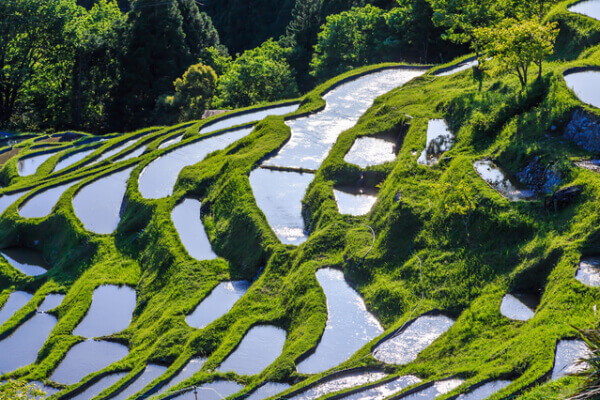Japan’s Terraced Rice Fields: The Beauty of Tanada Landscapes

In the heart of Japan’s countryside, away from the neon lights and bustling cities, lies a serene and picturesque landscape that has shaped Japanese culture for centuries: the terraced rice fields, known locally as “tanada.” These stunning agricultural marvels are not just a testament to Japan’s agricultural heritage but also a symbol of the harmonious relationship between humans and nature. This exploration into the world of tanada reveals the beauty, significance, and enduring charm of Japan’s terraced rice fields, offering travelers a path less trodden, rich with cultural insight and natural splendor.
The Essence of Tanada: An Introduction
The terraced rice fields of Japan are a breathtaking sight, especially in the planting season when the fields are filled with water, creating a mirror-like surface that reflects the sky above. These terraces, carved into mountains and hillsides, demonstrate ingenious agricultural practices developed over millennia to cultivate rice, a staple of the Japanese diet. The terraces not only prevent soil erosion but also utilize rainwater efficiently, showcasing an early form of sustainable farming.
A Journey Through Time: The History of Tanada
The history of rice cultivation in Japan dates back over 2,000 years, with the development of terraced fields being a later innovation as communities sought to maximize arable land in Japan’s mountainous terrain. These fields were painstakingly carved by hand and maintained through communal effort, reflecting a deep connection to the land and a collective spirit that is central to rural Japanese communities.
The Changing Seasons: A Canvas of Natural Beauty
The beauty of the terraced rice fields lies in their ever-changing appearance with the seasons. In spring, the fields are flooded, and the planting begins, creating a reflective surface that mirrors the sky. Summer brings a vibrant green as the rice plants grow, transforming the landscape into a verdant sea. Autumn sees the fields turn golden as the rice ripens, leading to the harvest, and in winter, the fields rest, sometimes covered in a blanket of snow, offering a stark but beautiful contrast to the surrounding landscape.
Tanada Today: Challenges and Preservation
Despite their cultural and aesthetic value, Japan’s terraced rice fields face challenges. The rural depopulation and aging farmer population have led to the abandonment of many terraces. However, there’s a growing recognition of their importance, leading to efforts to preserve these landscapes. Initiatives include promoting tanada tourism, encouraging younger generations to take up farming, and even involving city dwellers in rice planting and harvesting activities to foster a deeper connection with agriculture and rural life.
Experiencing the Magic of Tanada: Travel Insights
For travelers seeking Japan Tour Packages to experience the beauty and tranquility of Japan’s terraced rice fields, there are several destinations and activities to consider:
-
Visit the Iconic Tanada Destinations
The Shiroyone Senmaida in Ishikawa Prefecture offers a stunning view of over a thousand small rice terraces facing the Sea of Japan, especially breathtaking at sunset.
The Maruyama Senmaida in Kumano, Mie Prefecture, is another exquisite site, with over 1,340 terraces that have been cultivated for over 400 years.
The Ifugao Rice Terraces in the Philippines, a UNESCO World Heritage site, is often confused but worth mentioning for those interested in terraced rice fields globally.
-
Participate in Rice Planting and Harvesting
Several communities and farms across Japan welcome visitors to participate in rice planting in spring and harvesting in autumn. This hands-on experience provides insight into the hard work involved in rice cultivation and the satisfaction of harvesting.
-
Stay in a Local Farmhouse
Experience rural Japanese life by staying in a traditional farmhouse (minpaku) near the terraced fields. This allows for a deeper connection with the local community and landscape, offering a peaceful retreat from the hustle and bustle of city life.
-
Hiking and Photography Tours
For the more adventurous, hiking tours offer a way to explore the terraced landscapes up close. These fields also present incredible photography opportunities, capturing the beauty of the tanada through the seasons.
The Cultural Significance of Tanada
Beyond their agricultural purpose, the terraced rice fields hold deep cultural significance in Japan. They represent a way of life that is in harmony with nature, a philosophy that permeates Japanese culture. The tanada are a living reminder of the importance of sustainability, community, and the beauty of the natural world.
Conclusion
Japan’s terraced rice fields are a testament to the country’s agricultural heritage, ingenuity, and the enduring beauty of its rural landscapes. For travelers looking to explore beyond the urban excitement of Japan’s cities, the Japan Tour Packages from Mumbai offer a serene and deeply cultural experience that connects them with the land and its people. As these landscapes face the challenges of modernity, the growing interest and efforts to preserve them highlight their importance not just to Japan but to the world, as symbols of harmony between humanity and nature. Whether through participation in farming activities, a quiet retreat in a rural farmhouse, or a trek through the verdant fields, a visit to Japan’s tanada landscapes promises a journey of beauty, reflection, and connection.
--------------------------------
Guestbeat.com Notice!
Audience discretion is needed, Read TOS.
Submit Guest Post / Read Latest / Category List
App & Rate-Us / Subscribe Daily Newsletter (FREE)



